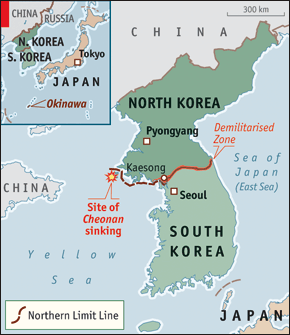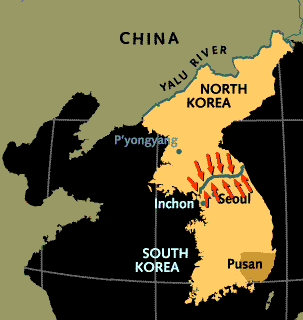The Cold War
"Mankind must put an end to war or war will put an end to mankind."
-President John F. Kennedy in his Address to the UN General Assembly (September 25, 1961)
The Korean War
(June 25, 1950 - July 27, 1953)
Background Information
-
Korean Peninsula occuppied by Japan until the end of WWII; Japan occuppied peninsula from 1910 - 1945.
-
Korea partitioned after WWII.
-
US occupied the south, Soviets occupied the north.
-
Korea divided at the 38th parallel (demilitarized zone), into South and North Korea respectively.
-
Two seperate governments established.
-
Causes
-
North Korea's invasion of South Korea.
-
Kim Il Sung was backed by the Soviet Union.
-
Image of US troops heading toward South Korea as civilians retreat, August 1950.
© Bettman/Corbis
America got involved in the North Korean conflict because there was fear of communism, the belief that communism would spread if one nation fell to communism (i.e. domino theory), and an increased fear of the Soviet Union's dominance in Asia as a result of the Sino-Soviet Pact of 1950 between China and the Soviet Union.
The Soviet Union supported North Korea in the conflict because doing so would strengthen communism in Asia, provide access to North Korea's atomic bomb, address anti-communist Japan, and increase the ability to compete with China.
China supported North Korea because it would be a way of saying 'thank you' for Kim Il Sung's support in the Chinese Civil War, and Mao Zedong thought doing so would increase his chances of becoming an international communist leader.


Communist North Korean forces capture the South Korean capital of Seoul June 25, 1950.

Joint US and UN forces are pushed back to southeast corner of Korean Peninsula--Pusan; July 5.

The Korean war ends in a stalemate right back where it began. General Matthew Ridgeway--after taking over the Eighth Army--led UN forces in a slow advance northward January 15; called the "meatgrinder." UN recaptured Seoul March 15.

Communist North Korean forces capture the South Korean capital of Seoul June 25, 1950.

Stages of the Korean War.
Map of the Korean Peninsula.
After North Korea invaded South Korea the UN considered North Korea the aggressor. The US made up the bulk of joint UN and US forces that General Douglas MacArthur led. September 1950, General MacArthur landed troops at Inchon near the Korean demarcation line. He led the attack on enemy supply lines--which was a strategy that worked and forced North Korea to withdraw near the Yalu River. However, General MacArthur was too aggressive, which arguably resulted in the failure of the conflict. November 1950, diplomats on the UN Security Council warned against the UN advancing toward China, but MacArthur ignored those warnings. November 25, a flood of conscripted Chinese troops inundated UN forces positioned at the Yalu River, forcing them south back over the demarcation line into South Korea.
The Korean War ended in the signing of a truce in 1953; Korea was divided the same way it had been before. Korea was left with no hope for unification, and the deaths of innocent civilians.